
The Advantages of Fiber-Reinforced Concrete
As the construction industry evolves, so does the technology and materials used in building projects. One such innovation that’s gaining momentum is fiber-reinforced concrete (FRC). As you embark on your next concrete-related construction endeavour, understanding the advantages of FRC is crucial for both you and your clients. Let’s delve into the seven key benefits of using fiber-reinforced concrete:
Cost-Effectiveness
According to the National Concrete Pavement Technology Center, FRC offers a cost-effective and sustainable solution for resurfacing and rehabilitating existing pavements. By adopting macro-synthetic fibers into designs, construction entities can reduce costs while enhancing project durability.
Reduced Labor
With the construction industry facing challenges in manpower availability and cost uncertainties post-pandemic, FRC provides a safer and more cost-effective working environment. By requiring fewer personnel on-site and reducing trip hazards, FRC accelerates construction timelines while minimizing environmental impact.
Streamlined Processes
By eliminating the need for conventional steel rebar, FRC reduces delays associated with steel placement inspections by municipalities. Ready-mix trucks can efficiently place concrete embedded with fiber reinforcement, minimizing finishing practices and expediting project completion.
Enhanced Durability
FRC maintains tight crack control, preventing water and aggressive solutions from penetrating beyond the concrete surface. This translates to improved long-term serviceability and reduced maintenance costs over the lifespan of the structure.
Temperature & Shrinkage Control
FRC serves as a cost-effective alternative to traditional reinforcement methods, guarding against temperature differentials and shrinkage issues commonly seen in concrete structures.
Lower Construction Costs
By reducing construction times, labor expenses, and long-term maintenance costs, FRC delivers significant savings for contractors and clients alike. These cost efficiencies can be passed on to customers, making projects more accessible and affordable.
Environmental Sustainability
FRC offers an environmentally friendly solution by utilizing recycled materials, such as steel fibers sourced from recycled car tire rims. Not only does this minimize landfill waste, but it also contributes to cost savings that benefit both businesses and customers.
Fiber-reinforced concrete isn’t just the future of construction; it’s a practical solution safeguarding the health and safety of construction personnel while bolstering the financial well-being of businesses and municipalities. Embrace this innovative material and pave the way for resilient, sustainable building projects.
Contact us for more detailed information and technical assistance, refer to Euclid Chemical’s Technical Bulletins and consult with our experts.






